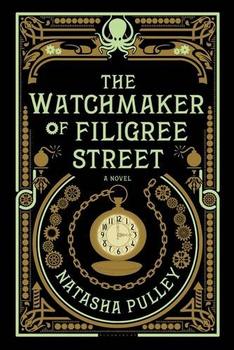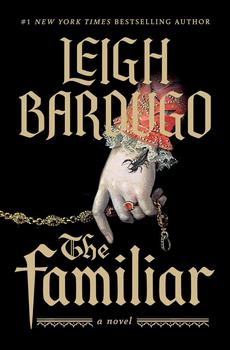Summary | Excerpt | Reading Guide | Reviews | Beyond the book | Read-Alikes | Genres & Themes | Author Bio

Critics' Opinion:
Readers' Opinion:
First Published:
Jul 2015, 336 pages
Paperback:
Jul 2015, 336 pages
 Book Reviewed by:
Book Reviewed by:
Sharry Wright
Buy This Book
Set in 1880s London, The Watchmaker of Filigree Street is a captivating and entertaining work of speculative fiction that starts out with a bang — a group of Irish nationals are threatening to set off bombs in public places around the city, including one targeting Scotland Yard.
The police's attempts to track down the alleged criminals drive the plot forward. The reader meets three complex and intriguing characters — Thanial, Grace and Mr. Mori — whose lives and fates collide and weave together as the story unfolds.
Thanial, a solitary telegraph operator working for the government's Home Office, has given up his dream of becoming a pianist in order to support his widowed sister and her sons living in Edinburgh. He has a condition that causes him to see color as sound which he keeps to himself for fear of being thought insane (today we would know this as synesthesia, see 'Beyond the Book'):
He took out the Lipton's, put the box diagonally in his cup and yesterday's Illustrated London News under his elbow, and made his way to the iron staircase. As he went down, it clanged in a bright yellow D sharp. He couldn't say why D sharp was yellow. Other notes had their own colors. It had been useful when he still played the piano because whenever he went wrong, the sound turned brown.
One day, after Thanial returns home to find someone has broken into his apartment, washed the dishes and left a gold pocket-watch on his pillow, he sets off to find out where it came from.
Grace, a physics student at Oxford, is desperately trying to prove the existence of ether in order to help explain ghosts, clairvoyants, and how thought has physical effects in the external world. To do so, she is building an interferometer, an instrument that measures light. She is passionately independent and in line to inherit her aunt's house where she can set up her own laboratory but will be forced into moving back into a stifling life at home with her narrow-minded parents unless she marries soon.
Keita Mori, a Japanese baron from a family of samurai knights, has recently moved to London for unknown reasons. He's a clockworks maker suspected of espionage. He has a charming clockwork pet octopus that steals socks, a garden full of clockwork fireflies and a diary that appears to tell the future. Mr. Mori is delicate, composed, refined, and highly intelligent with a secret gift beyond his ability to create exquisite watches and clockwork creatures.
While the well-paced plot, full of twists and surprises, centers on revealing the identity of the bomb-maker, the deeper story is really about friendship and following your heart to find out what and whom you love. Alienation, prejudice and the marginalization of foreigners as experienced by Keita Mori and other Japanese immigrants are also important themes throughout the story.
The tone is literary but lively with some clever bantering dialogue. The gritty, atmospheric setting of late nineteenth-century London is full of characters right out of a Dickens novel. The Victorian theatrical team of librettist W. S. Gilbert and composer Arthur Sullivan makes an appearance with a production of The Mikado and adds to the authenticity, while Mori's whimsical clockwork creations tosses in a dash of steampunk to the mix.
Each scene is brought vividly to life through detailed descriptions and visual writing. Here's when Thanial first meets Keita Mori:
Thanial set down his soaking umbrella and took the cup. It was green tea. He breathed in the woody steam, which cleared the soot from the back of his throat. He had meant to start asking questions straightaway, but the little foreigner had blindsided him. Although his clothes were English, they looked worn, and with his bad posture and his black eyes, they made him less like a breathing human than an expensive, neglected marionette."
My only complaint is that about two-thirds of the way through, the story loses track of the bomb threat plot for a while, focusing instead on the complicated relationship between the three central characters, Thanial, Grace and Mori. But this is easily forgiven when the issue resurfaces near the end resulting in a page-turning, high-stakes race that rewards the reader with a very satisfying conclusion.
I highly recommend this entertaining story to fans of speculative historical fiction and steampunk and anyone looking for a darned good read. Older teens will also enjoy this engaging novel.
![]() This review
first ran in the July 22, 2015
issue of BookBrowse Recommends.
This review
first ran in the July 22, 2015
issue of BookBrowse Recommends.

If you liked The Watchmaker of Filigree Street, try these:

by Téa Obreht
Published 2020
The New York Times bestselling author of The Tiger's Wife returns with a stunning tale of perseverance - an epic journey across an unforgettable landscape of magic and myth.

by Dolores Redondo
Published 2017
Already a #1 international bestseller, this tautly written and gripping psychological thriller forces a police inspector to reluctantly return to her hometown in Basque Country - a place engulfed in mythology and superstition - to solve a series of eerie murders.





The Flower Sisters
by Michelle Collins Anderson
From the new Fannie Flagg of the Ozarks, a richly-woven story of family, forgiveness, and reinvention.

The House on Biscayne Bay
by Chanel Cleeton
As death stalks a gothic mansion in Miami, the lives of two women intertwine as the past and present collide.

The Funeral Cryer by Wenyan Lu
Debut novelist Wenyan Lu brings us this witty yet profound story about one woman's midlife reawakening in contemporary rural China.
Your guide toexceptional books
BookBrowse seeks out and recommends the best in contemporary fiction and nonfiction—books that not only engage and entertain but also deepen our understanding of ourselves and the world around us.